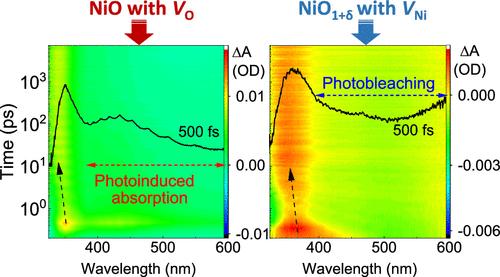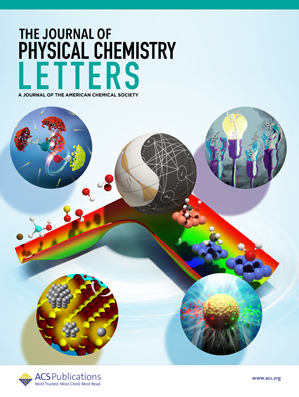Native Defect-Dependent Ultrafast Carrier Dynamics in p-Type Dopable Wide-Bandgap NiO
IF 4.8
2区 化学
Q2 CHEMISTRY, PHYSICAL
引用次数: 0
Abstract
NiO is a wide-bandgap p-type metal oxide that has extensive applications in optoelectronics and photocatalysts. Understanding the carrier dynamics in p-type NiO is pivotal for optimizing device performance, yet they remain largely unexplored. In this study, we employed femtosecond transient absorption spectroscopy to delve into the dynamics of photogenerated carriers in NiO films containing distinct prominent native defects: undoped NiO with oxygen vacancies (VO) and O-rich NiO (denoted as NiO1+δ) with nickel vacancies (VNi). Our findings unveil significant disparities between the two types of NiO thin films. The undoped NiO film exhibits a broad photoinduced absorption signal spanning the spectral range of 360–600 nm, whereas a photobleaching signal within the spectral range of 400–600 nm is observed in the O-rich NiO1+δ film, which can be attributed to their unique native defects. We ascertain that the fast formation of small electron polarons (SEPs) occurs within a delay time of approximately 200 fs. Subsequently, the photogenerated carriers undergo rapid trapping by localized states (e.g., grain boundary states) in undoped NiO and O-rich NiO1+δ within time scales of around 1–8 and 5–7 ps, respectively, followed by relatively slow trapping and recombination processes via native defects VO and VNi within time scales of approximately 200 ps and ∼2 ns, respectively. These findings illuminate the fundamental processes governing carrier dynamics in NiO thin films with different native defects, offering crucial insights for the advancement of NiO-based devices.

p型可掺宽禁带NiO中固有缺陷相关的超快载流子动力学
NiO是一种宽带隙p型金属氧化物,在光电子学和光催化剂方面有着广泛的应用。了解p型NiO的载波动态对于优化设备性能至关重要,但它们在很大程度上仍未被探索。在这项研究中,我们利用飞秒瞬态吸收光谱研究了NiO薄膜中光生载流子的动力学,这些薄膜含有明显的天然缺陷:含氧空位(VO)的未掺杂NiO和含镍空位(VNi)的富o NiO(记为NiO1+δ)。我们的发现揭示了两种类型的NiO薄膜之间的显著差异。未掺杂NiO薄膜在360 ~ 600 nm光谱范围内表现出较宽的光诱导吸收信号,而富o NiO1+δ薄膜在400 ~ 600 nm光谱范围内表现出光漂白信号,这可能是由于其特有的天然缺陷所致。我们确定了小电子极化子(sep)的快速形成发生在大约200秒的延迟时间内。随后,光生成的载流子分别在大约1-8和5-7 ps的时间尺度内,在未掺杂NiO和富o NiO1+δ中被局域态(例如晶界态)快速捕获,然后在大约200 ps和~ 2 ns的时间尺度内,通过原生缺陷VO和VNi进行相对缓慢的捕获和重组过程。这些发现阐明了具有不同原生缺陷的NiO薄膜中载流子动力学的基本过程,为NiO基器件的发展提供了重要的见解。
本文章由计算机程序翻译,如有差异,请以英文原文为准。
求助全文
约1分钟内获得全文
求助全文
来源期刊

The Journal of Physical Chemistry Letters
CHEMISTRY, PHYSICAL-NANOSCIENCE & NANOTECHNOLOGY
CiteScore
9.60
自引率
7.00%
发文量
1519
审稿时长
1.6 months
期刊介绍:
The Journal of Physical Chemistry (JPC) Letters is devoted to reporting new and original experimental and theoretical basic research of interest to physical chemists, biophysical chemists, chemical physicists, physicists, material scientists, and engineers. An important criterion for acceptance is that the paper reports a significant scientific advance and/or physical insight such that rapid publication is essential. Two issues of JPC Letters are published each month.
 求助内容:
求助内容: 应助结果提醒方式:
应助结果提醒方式:


